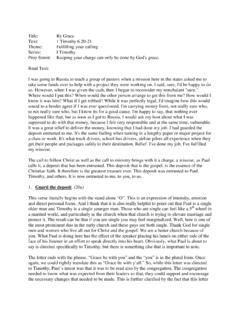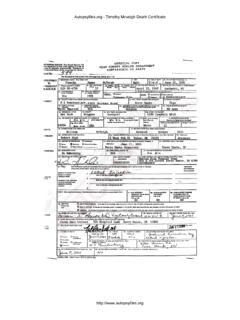Transcription of Paper 70-27 An Introduction to SAS Timothy J Harrington ...
1 Paper 70-27 An Introduction to SAS PROC SQL Timothy J Harrington , venturi Partners consulting , waukegan , illinois Page 1 of 6 Abstract This Paper introduces SAS users with at least a basic understanding of SAS data sets to the SAS SQL Procedure. The subjects discussed are (1) extracting specific data items and observations from data sets and views (2) creating and organizing new tables and views (3) creating and grouping summary statistics (4) joining two or more data tables (5) assigning data to SAS Macro variables (6) comparing and contrasting PROC SQL with the SAS DATA Step and other SAS Procedures. Creating output and new tables The SQL Procedure is a SAS Procedure, but uses the ANSI standards. This procedure begins with the declaration PROC SQL; and ends with a QUIT; statement (not RUN;).
2 In between these two declarations SQL code may be used. SQL code obeys the rules of the SAS system regarding maximum lengths of variable names, reserved words, and the use of the semi colon as the line delimiter. The simplest and most commonly used SQL statement is SELECT, which is used to extract data from a table. In this Paper the term table refers to either a SAS data set or a view. In the following simple example the contents of a table named VITALS are extracted and printed to the SAS output file. PROC SQL;SELECT *FROM VITALS;QUIT; The * means select all of the variables in the table. By default the data selected is printed to the SAS output window or file. If the VITALS table contains this information: OBS PATIENT DATE PULSE TEMP BPS BPD1 101 25 MAY01 72 130 882 101 01 JUN01 75 133 923 101 08 JUN01 74 136 904 102 30 JUL01 81 141 935 102 06 AUG01 77 144 976 102 13 AUG01 78 142 93 7 103 24 JUL01 77 137 798 103 31 JUL01 77 133 749 103 07 AUG01 78 140 8010 103 14 AUG01 75 147 8911 104 22 AUG01 72 128 8312 104 29 AUG01 69 131 8613 104 05 SEP01 71 127 82 This same table is printed to the next page of the output window, with the column names as headings but without the observation numbers.
3 To select individual columns the column names must be specified, separated by commas. PROC SQL, like a SAS DATA step, is often used to create new tables, and this is done using the CREATE keyword. CREATE TABLE creates a data set and CREATE VIEW creates a view. The following example creates a table called BP (Blood Pressure) and stores the Patient, Date, and Systolic and Diastolic Blood Pressure columns in that table. PROC SQL; CREATE TABLE BP AS SELECT PATIENT, DATE, BPS, BPD FROM VITALS; QUIT; Note: References to table names in PROC SQL may be followed with SAS keyword expressions such as DROP, KEEP, RENAME, and WHERE. In the above example, if instead, all of the columns in VITALS except TEMP are needed in the new table this code can be used: PROC SQL; CREATE TABLE BP AS SELECT * FROM VITALS(DROP=TEMP); QUIT; Duplicates and sorting To select unique values of one or more columns the DISTINCT keyword is used.
4 The following code produces a table of the unique patient numbers PROC SQL; CREATE TABLE PATIDS AS SELECT DISTINCT PATIENT FROM VITALS; QUIT; Sorting a table in PROC SQL by the values of one or more columns (sort keys) is achieved using the ORDER BY clause. In this next example, the table VISITS would be the same as the VITALS table but the observations would be sorted by increasing PATIENT values and then by DATE in reverse order (most recent date first). Reverse order is specified by using the DESCENDING keyword, after the column to which it applies. SUGI 27 Coders' CornerPage 2 of 6 PROC SQL; CREATE TABLE VISITS AS SELECT PATIENT, DATE FROM VITALS ORDER BY PATIENT, DATE DESCENDING; QUIT; Sub-setting and Calculating Just like in a SAS DATA step or any other SAS PROC edure the WHERE clause is used subset observations by one or more criteria.
5 In the example which follows a new table called BPODD is created using observations from the VITALS table where the values of PATIENT are 101 and 103. To use values in columns to perform calculations and to store such calculated results in a new column the AS keyword is used in the SELECT statement. In this example the value of TEMP, the temperature in Fahrenheit, is converted to degrees Celsius and the result is stored in TEMPC. Also, column attributes such as FORMAT, LABEL, and LENGTH can be assigned to columns in a SELECT statement. In this example the format DATE7. is assigned to the column date in the new table. Attributes in the original table columns are left unchanged. During the execution of this code the first event is the WHERE clause sub-sets the observations, then the calculations and column attribute changes are made.
6 The output table is then created and then sorted as specified by the ORDER BY clause. PROC SQL; CREATE TABLE BPODD AS SELECT PATIENT, DATE FORMAT=DATE7., BPS, BPD, (TEMP-32)/9*5 AS TEMPC FROM VITALS WHERE PATIENT IN (101 103) ORDER BY PATIENT, DATE DESCENDING; QUIT; PATIENT DATE BPS BPD TEMPC101 08 JUN01 136 90 01 JUN01 133 92 37101 25 MAY01 130 88 14 AUG01 147 89 07 AUG01 140 80 37103 31 JUL01 133 74 24 JUL01 137 79 An improvement which should be made to this table is to round the calculated result TEMPC to a predetermined number of decimal places. As in a SAS DATA step this is done using the ROUND function. Most SAS functions which can be used in a DATA step are also valid in PROC SQL code. For example the DATE column could be stored as a character string instead of a formatted numeric value by using the PUT function.
7 In this case DATE FORMAT=DATE7. would be replaced with PUT(DATE,DATE7.) AS CDATE LENGTH=7 CDATE would be a new column of character type and length 7 containing the formatted date as characters. In the following example a table called MEANBP is created which contains the mean blood pressure values BPS and BPD as BPSMEAN and BPDMEAN respectively. The COUNT function calculates the total number of observations selected (in this case all observations because no WHERE clause is used) and the result is stored in the new column N. These values are the means for the entire VITALS table stored in a single observation. The ROUND function is used to save the results rounded to two decimal places. PROC SQL; CREATE TABLE MEANBP AS SELECT COUNT(*) AS N, ROUND(MEAN(BPS), ) FORMAT= AS BPSMEAN, ROUND(MEAN(BPD), ) FORMAT= AS BPDMEAN FROM VITALS; QUIT; N BPSMEAN BPDMEAN13 Taking this a stage further, calculations can not only be performed on a whole table, but on groups of observations identified by key values.
8 One or more groupings are specified using the GROUP BY clause. In this next example the column N is the number of observations for each occurrence of the same value of PATIENT. Similarly the column BPDHIGH is the maximum BPD value for each PATIENT. The column BPDPCT is the percentage of each value of BPD as compared with BPDHIGH for the same PATIENT. To avoid calculating the same value of BPDHIGH twice the keyword CALCULATED is used to identify the calculated value of BPDHIGH for the same observation. If the word CALCULATED was omitted a Column not found error would result because BPDHIGH is not a column in the input table VITALS. PROC SQL; CREATE TABLE HIGHBPP1 AS SELECT PATIENT, COUNT(PATIENT) AS N, DATE FORMAT=DATE7., BPD, MAX(BPD) AS BPDHIGH, ROUND(BPD/(CALCULATED BPDHIGH)*100, ) FORMAT= AS BPDPCT FROM VITALS GROUP BY PATIENT; QUIT; SUGI 27 Coders' CornerPage 3 of 6 PATIENT N DATE BPD BPDHIGH BPDPCT101 3 08 JUN01 90 92 3 25 MAY01 88 92 3 01 JUN01 92 92 3 30 JUL01 93 97 3 06 AUG01 97 97 3 13 AUG01 93 97 4 31 JUL01 74 89 4 07 AUG01 80 89 4 24 JUL01 79 89 4 14 AUG01 89 89 3 05 SEP01 82 86 3 29 AUG01 86 86 3 22 AUG01 83 86 Assume now there is a requirement to create a table like this one but containing only the observations where the value of BPD is equal to BPDHIGH.
9 A WHERE clause can be used to subset observations from the input table, but this keyword cannot be used with calculated values. Instead the HAVING keyword is used. HAVING is like a second WHERE clause, acting on the results of the WHERE and newly calculated values before producing the output table. In this next example the WHERE clause selects an observation from VITALS only if the value of PATIENT is 101, 102, or 103. The maximum value of BPHIGH is then calculated for each patient (the GROUP BY clause). The HAVING clause then compares the current value of BPD with the calculated maximum for the given group (PATIENT). If the HAVING condition is true the observation is output to HIGHBPP2. In this example if there were two or more values of BPD which equaled BPHIGH, all of these matching observations would be output. Finally the output data set is sorted in order of the increasing value of the calculated column BPDHIGH.
10 The result is a table of one observation per patient and their maximum blood pressure reading, sorted in order of increasing maximum blood pressure value. PROC SQL; CREATE TABLE HIGHBPP2 AS SELECT PATIENT, COUNT(PATIENT) AS N, DATE FORMAT=DATE7., MAX(BPD) AS BPDHIGH FROM VITALS WHERE PATIENT IN (101 102 103) GROUP BY PATIENT HAVING BPD = CALCULATED BPDHIGH ORDER BY CALCULATED BPDHIGH; QUIT; PATIENT N DATE BPDHIGH103 4 14 AUG01 89101 3 01 JUN01 92102 3 06 AUG01 97 To calculate values based on conditions on column values in the input table the CASE construct is used. This is like the IF THEN or the SELECT construct in a SAS DATA step. The general syntax of the CASE construct is CASE <expression> WHEN <value 1> THEN <value A> WHEN <value 2> THEN <value B> .. ELSE <value Z> END AS <result column>. Values 1,2,3.

















